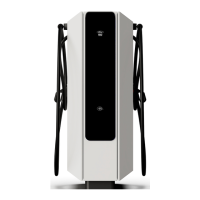CABLE ACCESS AND CONNECTIONS
Connections
This section details the input and output connections that must be performed in the equipment.
There are several factors that can influence the choice of cable, including the distance between the
distribution board and the charger, the maximum input current and the installation mode.
The dimensioning of the cables must be checked by a qualified electrician. The customer is
responsible for the correct sizing and execution of the corresponding connections in accordance with
the regulatory requirements applicable in the country of installation.
To guarantee proper electrical installation, it is very important to comply with the bend radius of
the cable.
To guarantee proper insulation, it is very important the cable diameter is within the tolerable range
of the cable gland.
The power cables and RJ45 connector must be inserted into the equipment without crimping the
terminal, or they will not be able to pass correctly through all the expected spaces. Forcing them could
affect the sealing of the equipment.
The AC connection is composed of three phases, ground wire and the neutral wire. Both, the power
supply input/output and the communication connections input/output will be introduced through one of
the accesses and will pass through their corresponding space in the internal cable entry plate to reach
the connection panel.
Note: The equipment does not require auxiliary power supply input, because it includes an internal
transformer.
AC input power connections
Cable size:
The tables below show the recommended cable size for the NB 120 range equipment. Customer must
choose the cables taking into consideration the minimum and maximum diameter, as well as the
particularities of the project:
INPUT POWER SUPPLY (L1, L2, L3)
GROUND AND NEUTRAL (PE, N)

